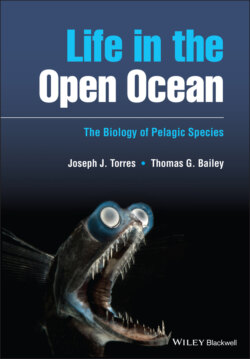Читать книгу Life in the Open Ocean - Joseph J. Torres - Страница 57
Severity of Oxygen Minima, “Dead Zones,” and the Intertidal
ОглавлениеIt is important to appreciate the difference between oceanic oxygen minima, which are persistent, year‐round features located predictably in certain regions of the global ocean for millennia, and the seasonally appearing regions of hypoxia or “dead zones” like that at the mouth of the Mississippi River in the Gulf of Mexico (Rabalais et al. 1994) or in the deeper water of some Scandinavian fjords during summer (Diaz and Rosenberg 1995). The persistence and predictability of oceanic oxygen minima have allowed for adaptations in their resident fauna that enable a primarily aerobic existence. In contrast, the seasonally or episodically appearing anoxia of dead zones, as well as their duration and severity, precludes such adaptation. Infaunal species and any others with limited mobility experience 100% mortality in dead zones (Diaz and Rosenberg 1995). Life in both the oceanic oxygen minima and the episodic dead zones differs from the situation in the intertidal, where high intertidal species may experience anoxia twice daily but a return to normoxia is assured with the incoming tide.
At what concentration does oxygen become limiting in oxygen minima? A good indication is a reduction in the biomass or the diversity of the fauna inhabiting them. Childress and Seibel (1998) observed that oxygen has little influence on the biomass or species composition of midwater organisms inhabiting minima down to a level of 0.20 ml l−1 or 0.63 kPa. At oxygen concentrations of 0.15 ml l−1 and below, such as that in the Eastern Tropical Pacific or Arabian Sea, oxygen minimum zones (OMZ’s) exhibit reduced biomass and diversity. In those cases, anaerobiosis while resident in the minimum accompanied by a vertical migration out of the layer to more highly oxygenated waters at night is the most likely strategy (Childress and Seibel 1998).
Intertidal species, including those that dwell in burrows as well as epifaunal species such as bivalves that are exposed for extended periods, are usually highly competent anaerobes (Hochachka 1980). Their situation as intertidal dwellers is fundamentally different from that of oxygen‐minimum‐layer species. Their anoxia and normoxia are cyclic, varying with tidal exposure. Thus, it is adaptive to be able to extract oxygen efficiently, but only down to the point where a large investment in the systems involved in oxygen uptake and transport is unnecessary. For most species, that point lies in the partial pressure range of 20–30 mm Hg oxygen or 2.7–4.0 kPa (Torres et al. 1979, 1994; Childress and Seibel 1998). For intertidal species, oxygen availability will continue to decline to or near zero oxygen as the tide recedes and anaerobiosis inevitably will become necessary.
In the deep sea, it is the stability of oxygen minima in concert with the limited food resources that have allowed the highly efficient respiratory systems of oxygen‐minimum‐layer fauna to arise.
